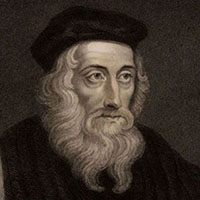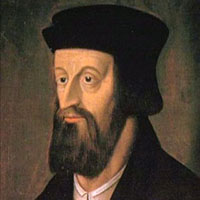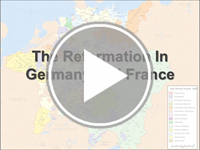
Religious Wars and Catholic Reformation
The history of the Catholic Church from the 1300s to the 1500s included other well-known dissenters, or people that disagreed with the doctrines and or authority of the Catholic Church. Prior to Martin Luther, two other well-known dissenters were Jan Huss and John Wycliffe. Roll over the two images below to find out more about these men.
John Wycliffe

John Wycliffe was an English theologian who lived during the 1300s. An advocate of centering religion on the teachings of the Bible, he translated the Bible into English in 1382. After his death, he was declared a heretic by the Catholic Church. More than forty years after his death, his remains were dug up and burned along with his books and translations. Wycliffe is considered one of the early leaders of the Protestant Reformation since his ideas were important to Martin Luther's core teachings.
Jan Huss

Jan Huss was a priest who lived in what is now the Czech Republic. He criticized certain parts of Church doctrine similar to those criticized by the leaders of the Protestant Reformation. In response, Church officials found him guilty of heresy and burned him at the stake.
Catholic Reformation
The leaders of the Catholic Church were not content to allow the Protestant critics to attack Church teachings and win over followers. In response, Catholic leaders looked to make changes within the Church to keep it strong, while addressing some of the problems they were having. This movement became known as the Catholic Reformation, or Counter Reformation.
The Catholic Reformation began when Church leaders came together at the Council of Trent, which met from 1545 to 1563. Over 25 sessions, these leaders revised or redefined the Church's teachings in an attempt to stop people from leaving the Catholic Church and becoming Protestant. Its actions fall into three main campaigns.
First, Church leaders looked to reaffirm or restate Catholic doctrine, church practices, and rituals in response to the criticisms of the Protestants. Next, Church leaders set up The Society of Jesus, also known as Jesuits, in order to spread the word of the Church. Jesuit missionaries were sent to spread Catholic doctrine in Europe and the rest of the world. The final action of the Council of Trent was the reinstatement of the Inquisition, which were Church courts set up to prosecute Protestants and others as heretics. The purposes of these courts were to reinforce Catholic doctrine and to limit the spread of Protestantism.
Most of the reforms of the Catholic Reformation were focused on strengthening the positions of Church teachings, many of which were the same teachings that the Protestant Reformers criticized in the first place. This did little to win over those who were drawn to the ideals of the Protestant movement. With the inquisitions in place to prosecute heretics, and political leaders lining up under the banner of the competing churches, there was a tense political and religious climate that would lead to war.
Fallout from the Protestant and Catholic Reformations

Many Germans would break from the Catholic Church and follow the teachings of Martin Luther. Meanwhile, France would remain a Catholic country, although it had a sizeable Protestant population. View this presentation to learn how the Protestant and resulting Catholic Reformations would lead to political changes in Europe. In combination with religious differences, these movements would result in war and destruction across Europe. Click the player to begin.
Download a printable version of the interactivity.
A Changing World
The changes that accompanied the Protestant and Catholic Reformations brought huge transformations in cultural values, traditions, and philosophies. In addition to new views on religious doctrine, a number of other changes occurred including a growth of secularism (focus on worldly as opposed to spiritual concerns), the growth of individualism, and eventually, a rise in religious tolerance.
The Gutenberg printing press was the technology at the center of the Protestant Reformation, as it allowed for the mass dissemination of Martin Luther's ideas. As literacy rates climbed, more people were able to read the Bible, which was translated and printed in English, French, and German. This had a huge impact on the spread of the ideas of the Reformation and the Renaissance.
Catholic Reformation Review

Now that you have explored the Catholic Reformation and the ensuing religious and political changes, take a moment to check your knowledge in this interactivity. Make sure that you are familiar with the terms presented in this review interactivity. Click the player to get started.


